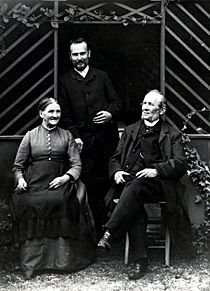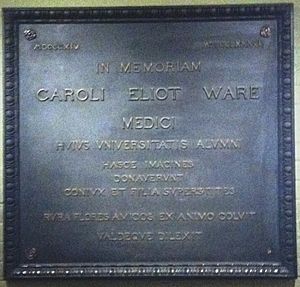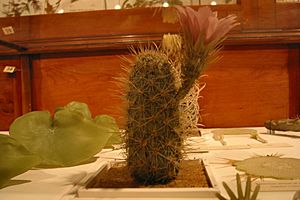Glass Flowers facts for kids
The Ware Collection of Blaschka Glass Models of Plants, often called the Glass Flowers, is an amazing collection of super realistic glass plant models. You can find them at the Harvard Museum of Natural History in Cambridge, Massachusetts, USA.
These incredible models were made by a father and son team, Leopold and Rudolf Blaschka. They worked on them from 1887 until 1936 in their studio in Hosterwitz, near Dresden, Germany. The idea for this collection came from George Lincoln Goodale, who was the first director of Harvard's Botanical Museum. The project was paid for by Mary Lee Ware and her mother, Elizabeth C. Ware.
The collection is huge! It has 847 life-size models, showing 780 different kinds of plants. There are also about 3,000 smaller models that show tiny parts of plants, like how their cells are structured. In total, there are around 4,400 individual glass models representing over 830 plant species. Some models even show how fungi can cause plant diseases, especially on plants like roses.
How the Glass Flowers Began
Before making plants, the Blaschkas were famous for creating glass models of marine invertebrates, like jellyfish and sea anemones. They started this business in 1863 and sold their glass sea creatures to museums and collectors all over the world. You can learn more about their other work by looking up Glass sea creatures.
Back then, scientists usually studied plants by pressing them flat and drying them. These pressed plants lost their natural 3D shape and their bright colors. In 1886, Professor Goodale saw the Blaschkas' glass sea creatures. He was so impressed that he traveled to Germany to ask them to make glass plant models for Harvard. He wanted models that would keep their 3D shape and color forever.
Leopold Blaschka wasn't sure at first, but he agreed to make some sample models. Even though these samples got a bit damaged on their journey, Professor Goodale saw how valuable they would be for teaching about plants.
Funding the Project
To pay for this big project, Professor Goodale asked Mary Lee Ware and her mother, Elizabeth C. Ware, for help. They were already very generous supporters of Harvard's plant department. In 1887, they agreed that the Blaschkas would work half-time on the glass plants. But by 1890, the project was so important that the Blaschkas started working on it full-time.
The work continued for many years, until 1936. By then, both Leopold Blaschka and Elizabeth C. Ware had passed away. The entire collection is dedicated to Dr. Charles Eliot Ware, who was Mary's father and Elizabeth's husband.
Making the Amazing Glass Models
The glass models are made mostly of glass, but they also have wire supports (some inside, some outside). Glue and different kinds of natural materials were used, along with paint or enamel colors. The Boston Globe newspaper once said they were "perfect in every detail and impossible for other glass-workers to copy."
People often thought the Blaschkas had secret techniques that were lost. But actually, the methods they used were common at the time. What made them special was their incredible skill, passion, and how carefully they studied real plants. Leopold Blaschka once wrote that the only way to become a skilled glass modeler was to "get a good great-grandfather who loved glass." This shows how much their family tradition of craftsmanship meant to them.
The Blaschkas mainly used a technique called lampworking. This is where glass is melted over a flame, often powered by air from a foot-pumped bellows. Then, they would shape the soft glass using tools to pinch, pull, or cut it. They also blew glass to create hollow forms. You can even see their old-fashioned lamp-working table at the museum!
Over time, Rudolf Blaschka took more and more control over the whole process. He even started making his own glass and colors.
A plant scientist named Donald Schnell called the models "enchanting." He was surprised to find that the models showed a tiny detail about how a bee pollinates a certain plant. This was a detail he had only guessed at himself! Experts Whitehouse and Small wrote that the Blaschka models are better in design and making than any modern models, and their skill will be remembered forever.
See also
- Artificial flowers
- Glassblowing
- Lampworking





